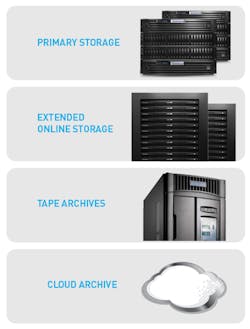Increased use of analytic tools, longer retention time for data, and accelerating adoption of high definition cameras have changed the surveillance industry. More capacity is needed, and companies no longer can afford to treat storage as an afterthought. As a result, storage has become a central component of today’s surveillance architecture and a big piece of the budget.
According to industry analyst IHS, high definition camera unit shipments are projected to grow at 43 percent annually from 2014-2019, and for the first time, global shipments of IP-based cameras were expected to exceed shipments of analog cameras by the end of 2015. As it turns out, your customers are opting for HD cameras faster than IHS predicted, leading them to nearly double their original storage projections.
More high resolution cameras are driving the need for more storage. Just two years ago, newly installed surveillance cameras generated 413 petabytes of data a day, based on information collected by IHS. The amount of data produced in just one day by all the new video surveillance cameras installed worldwide in 2015 was 566 petabytes. Estimates show that by the end of 2019, new security cameras will be generating more than 2,500 petabytes of data on a daily basis.
While more cameras and higher resolutions are impacting the need for more storage, so is retention time. Legal and regulatory requirements continue to change, resulting in longer data retention times for the organizations security integrators serve. Time frames may vary by industry, but one fact remains: video surveillance data is being retained longer to aid in the prosecution of crimes and to protect organizations from potential litigation.
The Impact of Analytics
Advancements in big data and analytics have impacted nearly every industry, and surveillance and security is no exception. Organizations continue to search for new ways to use the staggering amount of unstructured data they are capturing and are pressing toward more predictive and prescriptive analytics. According to Gartner, businesses are increasing their investment in advanced analytics; in fact, the global video analytics and intelligent video surveillance market is expected to grow at 14 percent per year and hit $22B by 2020, according to IHS.
Succeeding in today’s global economy requires organizations to focus on innovation as well as operational efficiency and differentiation. Analytics can help companies identify new market opportunities, better understand their operations, and gain insight into customer preferences and behavior.
Video surveillance footage has been a valuable tool for protecting people and property, and the need for it isn’t going to change anytime soon. The National Retail Federation (NRF) notes that retailers lost $44 billion from inventory shrink in 2014; however, as video content analytics (VCA) solutions become more sophisticated, video surveillance footage is being used for more than just loss prevention.
As companies become more experienced in manipulating unstructured data to identify patterns and trends, traditional surveillance data is moving in the direction of what can be called video-based data and used for business purposes. For example, retailers are using video data for heat mapping — a process that captures hot spots, idle locations, and bottlenecks within stores — as well as monitoring other aspects of shopper behavior to improve store layouts, customize marketing promotions, and increase sales. In addition, transportation companies are using video data to track cargo through ports and rail yards to improve efficiency.
In manufacturing, video-based data can be combined with other information, such as input from sensor technology like RFID, to track product flow and improve operational efficiencies in logistics and manufacturing.
Storage Infrastructure Becomes Vital
To realize business value from video data, it must be kept for a long time and analyzed using advanced analytics — which requires a storage infrastructure capable of providing long-term retention of data without sacrificing performance or busting the budget.
For the storage infrastructure to deliver optimal results, it must be flexible, high performing and affordable, while ensuring files are easily accessible. A proven approach is to implement a tiered infrastructure — optimized for video files — that can be viewed as a single file system.
In a tiered architecture, multiple levels of storage exist — high performance disk, secondary disk, tape, and cloud — enabling data sets to be stored on the most cost-effective medium based on user-defined policies. High priority, frequently-used files are stored on high-performance disk while less frequently accessed files are stored on high-capacity disk, tape or in the cloud.
With a single file system view, the system manages the movement of the data between tiers and the metadata remains intact, allowing files to be retained cost-effectively for a long period of time and still remain accessible for analysis when needed.
A tiered architecture provides many benefits. It is flexible and can scale as needed to accommodate growth as camera counts go up, retention times increase, image formats change and file sizes grow larger. With a single file system view, data can be kept longer and searched more easily, lowering the cost of storage and enabling analytics to be performed more effectively.
Engage with Customers
The surveillance industry is undergoing a transformation, and storage is at the heart of it. With the business use of video data becoming more widespread, the old approaches to storage simply no longer work. High-definition cameras and longer retention times due to legal and regulatory requirements are driving the need not only for more capacity to handle the increased volume, but also for more affordable storage architectures to lower the cost of long-term data retention and to enable business analytics.
Companies are beginning to realize business value from video data beyond simply loss prevention. Organizations are beginning to see tangible return on investment (ROI), and that is good news for the security services industry.
The key is to engage your customer in a storage conversation. Whether you realize it or not, it is on their mind, and it is becoming a big part of their budgets. Ask them: What do they want to get from their surveillance data? How do they envision using it? Do they foresee business uses for the data beyond protecting people and loss prevention? Do they want to spend less on storage and more on cameras and analytics?
Discussing storage with your customer enables you to expand the conversation into new areas, potentially opening up new opportunities. The more you understand about your customer’s plans, the better guidance you can provide. And that not only helps you to serve them better but also positions you as a valuable partner.
Wayne Arvidson is Vice President of Video Surveillance and Security Solutions for Quantum. Request more info about the company by visiting www.securityinfowatch.com/12108385.



